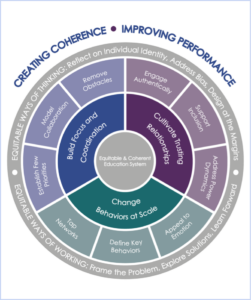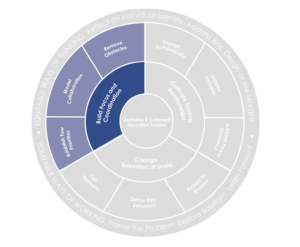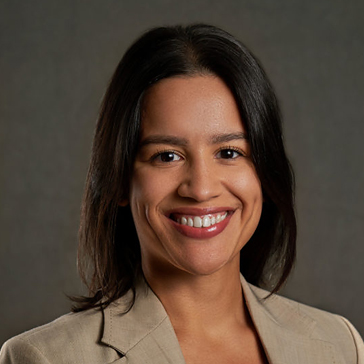Has your team or organization grappled with inconsistent communication, conflicting policies, or siloed practices? If so, you’re not alone. These challenges are all too common for teams and organizations trying to work well together. These challenges, among others, often ruin collaboration, undermine equity, and erode trust within teams and across partnerships.
We see this fragmented approach to collaboration almost everywhere – education reform often takes on a siloed approach, which results in isolated policies, strategies and practices. This is true across different issue areas, at state and local education agencies and even between foundations and their grantees.
Disconnected teacher preparation practices is one example of the type of fragmentation that exists in our education system. In response to growing teacher shortages, we see district leaders making critical decisions to staff classrooms from a limited pool of qualified teachers. But what’s a long-term solution? Building stronger partnerships between districts, schools and teacher preparation programs so that districts have access to a healthy pipeline of teachers who are prepared to thrive in specific school contexts.
How do we get there? By focusing on coherence.
 This means increasing focus and coordination on teacher preparation practices, policies and expectations within and across districts, schools and teacher preparation programs. It also means developing the mindsets, skills and structures to identify and address barriers to equity and collaboration, like siloed communications and lack of trusting relationships with individuals, teams and communities.
This means increasing focus and coordination on teacher preparation practices, policies and expectations within and across districts, schools and teacher preparation programs. It also means developing the mindsets, skills and structures to identify and address barriers to equity and collaboration, like siloed communications and lack of trusting relationships with individuals, teams and communities.
Members of the New York City Public Schools Office of Teacher Recruitment & Quality (NYCPS) and the State University of New York Urban Teacher Education Center (SUNY SUTEC) were able to overcome these barriers to collaboration that so many leaders face. NYCPS and SUNY SUTEC partnership members were determined to reduce silos and barriers in their shared teacher preparation work. Their goals were two-fold: strengthen their district-university partnership to provide more rigorous and robust teacher preparation for SUNY student teacher candidates and increase the number of teacher candidates from SUNY institutions ready and hired to teach in NYC public schools.
NYCPS and SUNY SUTEC partnership members participated in the Coherence Lab Academy where they focused on strengthening their approach to collaboration so that the two organizations, as partners, could be better prepared to work together toward their goals for teacher preparation in New York City. As a result of the Coherence Lab Academy, NYCPS and SUNY SUTEC partnership members were able to clarify a shared vision and commitment to equity, build trust, improve their working relationship and strengthen their ability to build a more sustainable pipeline of diverse, excellent teachers in NYC.
How NYCPS & SUNY SUTEC increased their focus and coordination
 In the Coherence Lab Academy, NYCPS and SUNY SUTEC members identified a clear disconnect in the pedagogical content and clinical placements that student teachers in the SUNY system experience before entering NYCPS classrooms. They cited inconsistent communication and conflicting policies across their institutions as some of the root causes for this disconnect.
In the Coherence Lab Academy, NYCPS and SUNY SUTEC members identified a clear disconnect in the pedagogical content and clinical placements that student teachers in the SUNY system experience before entering NYCPS classrooms. They cited inconsistent communication and conflicting policies across their institutions as some of the root causes for this disconnect.
NYCPS and SUNY SUTEC members needed a way to establish a few shared priorities for clinical preparation and develop structures to collaborate more consistently on those priorities. Before identifying those priorities, they focused on developing a shared vision to clarify how they would work together moving forward. A true NYCPS and SUNY SUTEC partnership means that, over time, they will address many problems and priorities within the teacher preparation continuum, so establishing a vision allows members in the partnership to define the collaborative path forward regardless of changes to priorities over time.
Having established a clear vision, partnership members identified a few shared priorities and differentiated where communication and coordination were more powerful than collaboration. They also considered what knowledge, skills and structures needed to be in place to support collaboration, learning and change within the partnership.
NYCPS and SUNY SUTEC partnership members committed to establishing three collaboration structures and practices that align to their shared priorities:
Building focus and coordination doesn’t happen in a vacuum – establishing few priorities, modeling collaboration and removing obstacles requires leaders at all levels of the system to create and support the conditions and structures for collaboration, cultivate trusting relationships and champion mindset shifts that disrupt inequitable practices.
Along the way, NYCPS and SUNY SUTEC members interrogated their identities, biases and proximity to power, conducted empathy interviews and root cause analysis to understand the experiences of people most proximate to the problem and used their learnings to develop a deeper understanding of the problem to design more equitable solutions. In the end, members left the Coherence Lab Academy with the necessary mindsets, skills and tools to continue tackling barriers to collaboration and coordination across any of their shared teacher preparation priorities.
Closing
The Coherence Lab Academy is a 10-month long engagement where teams of education systems leaders work to identify a systemic challenge and design coherent, equitable solutions. The Academy builds participants’ knowledge and skills in four critical elements of coherence: building focus and coordination, cultivating trusting relationships, changing behaviors at scale and equitable ways of thinking and working. These research-backed elements are known as the Coherence Framework and can be applied in any context – from creating internal coherence within one organization to creating external coherence to support organizational partnerships, as in the case of NYCPS and SUNY SUTEC.

